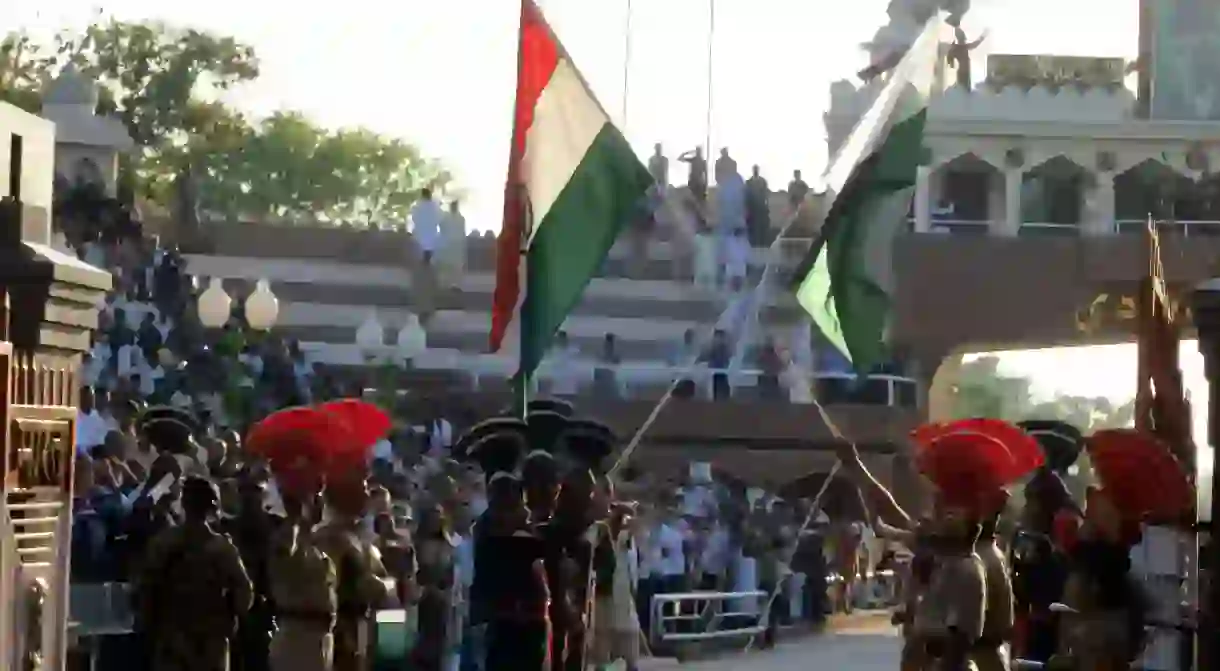Wagah Border: The Guard Ceremony

The rivalry between India and Pakistan goes back to the year in which the state of Pakistan was created. India was cut into two halves based on religious differences. From that fateful night in 1947 until this very day, both the neighboring nations are at loggerheads with each other. So it is no wonder that the borders the two countries share are very sensitive. Wagah border is one such border. Except it is much more than a border: Wagah is the symbol of rivalry and brotherhood.
Wagah is a village that is 32 kilometers from Amritsar in India and 24 kilometers from Lahore in Pakistan. The village is located at the Radcliffe line, the demarcation line that was drawn when India was partitioned. Wagah lies 600 meters west of the line. In Pakistan the border crossing is known as Wahga border. However, in India, the border crossing is known as Atari border crossing, named after the village Atari that lies 500 meters from the line within the Indian boundary.
It is here at the Wagah-Atari border that the Indian Border Security Force (BSF) and Pakistan Rangers (PR) showcase a tradition that has been followed two hours before sunset every day since 1959: the lowering of the flags ceremony.

The ceremony begins with a vaunt parade by the soldiers from both the sides, and ends with perfectly coordinated lowering of the flags of both the countries. This ‘beating retreat’ border ceremony is one of the most witnessed military ceremonies that attracts crowds from both the sides of the border, as well as international tourists. The boot thumping, eye-to-eye stares, the martial cries, and the overall ferocity of the ceremony makes it entertaining for the crowd. They chant and cheer; ‘Pakistan Zindabad’ and ‘Jai Hind’ echo in the background.
The zealous patriotic display and the need to outdo each other forces the guards to display an extraordinary amount of choreographed contempt. The hostility is electrifying. The ceremony that was started as a goodwill gesture turned overly competitive and aggressive after a few years. The full ceremony lasts close to two hours. The gallant display begins with soldiers from both sides standing to attention on each side of the iron gates. They march ahead, full of vigor and with each blustering step their kick goes higher up in the air. As the sun sets into the horizon, the iron gates at the border are opened and the two flags are lowered simultaneously. The synchronized lowering of the flag signifies the respect for the value of cooperation between the arch-rivals. After the lowering, in a swift moment, the flags are folded and the ceremony ends with a retreat. The retreat in itself is a delight to watch. It involves a firm handshake between the soldiers of both the sides. It is then followed by the closing of the iron gates and an equally steadfast march back to their positions. The spectacle is one of a kind. The sheer rivalry and the cheering from either side makes this an exciting event to witness.
https://youtube.com/watch?v=ON-6vyQugw4
The ceremony has come under criticism because of the aggression displayed. There have been mentions of toning down the ferocity of the display from both the sides. The ceremony that was once started with the purpose of handshake has been made into a stand-off. But somewhere it is this belligerence that is feeding the 5,000 plus spectators.













